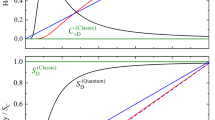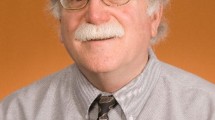Abstract
The paper aims at characterising and documenting a fundamental change in how phase transitions were modelled microscopically in the period 1937–1970. At first, physicists took what will be called a naturalistic approach to phase transitions such as the condensation of gases and the Curie point of ferromagnets. Here the purpose was to explain the phenomenon in question, i.e., to show that a model exhibits the same features as the phenomenon. The scope of this approach was broad, as the goal was to account for several aspects of the phenomenon. The employed model should be very realistic and close to the foundational theory, be it classical or quantum mechanics. In the 1960s, the physicists used an alternative approach that they termed a caricature approach. This approach not only required explanation in the above sense but also understanding of the physical phenomenon, i.e. insights into why the phenomenon behaves as it does. The scope was limited to certain aspects of the phenomenon, such as the behaviour near the critical point. The caricature approach used a hierarchy of models, ranging from realistic ones over more simplified models to models that were mere caricatures of the system in question. Hence, the two approaches represent very different orientations when it comes to the purpose and scope, the organisation of the resulting theories, and what models are acceptable.




Similar content being viewed by others
Notes
In 1950, Shigetoshi Katsura and Hisaaki Fujita echoed this description of the program [Katsura and Fujita [18]].
Mayer et al. had to make some inessential limitations as well, which can be removed at the cost of a more complicated examinations: a) The molecules are identical; b) the number of molecules N is so large that terms of the order \(\mathrm {N}^{\mathrm {-1/3}}\) can be ignored compared to unity; and c) the only degrees of freedom of the molecules are the translational ones.)
Published the following year as [Fisher [8]].
The model was introduced under the heading ‘simple models’ along with the Heisenberg model for magnetism and he wrote that “the classical continuum gas model is probably the most realistic.” [Fisher [8], p. 27].
Temperley wrote for instance that the interaction of another model “is a crude approximation to a Lennard-Jones type of interaction” [Temperley [32], p. 234]
C.N. Yang and T. D. Lee proposed a model in 1952, that was close to Mayer’s model [Yang and Lee [35]]. Benjamin Widom [Widom [34]] published a paper in 1957, where he examined a model like Mayer’s (though he added further approximations). Another example is Temperley’s influential book of 1956 on phase transitions. Here he reviewed “five possible liquid models,” [Temperley [32], p. 52.] and concluded that the one of the most promising lines of approach seem to Mayer-type theory.
The paper seems to have been written some years earlier.
It should be noted, however, that the details of their endeavors differed in that Domb and Miedema, in contrast to Temperley, did not (and perhaps did not want to) decide between more complex theories dealing with iterant nature of the electrons.
The title of his dissertation of 1967 at Harvard, “Critical Phenomena in Heisenberg Models of Magnetism,” reveals his preoccupation with the Heisenberg models, which are general spin models with nearest-neighbour interaction. These models were the subject of a series of papers that he wrote from the middle of the 1960s to the early 1970s. Their overall theme was to determine, in the words of one of the titles, the “[d]ependence of critical properties of Heisenberg magnets upon spin and lattice”. In the very early 1970s he turned the issue raised in the above title from a question that was interesting but of limited scope, into a question of central importance for the theory of critical phenomena.
These factors, which concerned the properties of the interactions, were (i) the uniformity of the direction of the interaction between nearest-neighbours (ii) the range of interaction (what happens if further than nearest neighbours are taken into account?); and (iii) the symmetry of the interaction between two spins (what happens if there is an asymmetry, for instance in the z-component of the interaction?).
References
Als-Nielsen, Jens and Ove W. Dietrich. 1967. Long-range order and critical scattering of neutrons below the transition temperature in \(\beta \)-brass. Phys. Rev. 153: 717-721.
Anderson, Philip W. 2001. Science: A ‘Dappled World’ or a ‘Seamless Web’? Stud. Hist. Phil. M. P. 32: 487-494.
Brush, Stephen. 1983. Statistical physics and the atomic theory of matter: from Boyle and Newton to Landau and Onsager. Princeton Univ. Press, Princeton.
Baxter, Rodney J. 1982. Exactly solved models in statistical Mechanics. Academic Press, New York
Boer, Jan de. 1952. Théorie de la condensation, Changements de Phases. Comptes Rendus de la deuxième Réunion Annuelle tenue en commun avec la Commission de Thermodynamique de l’Union Internationale de Physique, Société de Chimie Physique, Presse Universitaires de France, Paris, 8–18.
Domb, Cyril. 1996. The critical point: a historical introduction to the modern theory of critical phenomena. London: Taylor and Francis.
Domb, Cyril and Andries Rinse Miedema. 1964. Chapter VI Magnetic Transitions. Prog. Low Temp. Phys. 4: 296-343.
Fisher, Michael E. 1965. The nature of critical points. In Lectures in Theoretical Physics, ed. Wesley E. Brittin, VII C: 1-159. Boulder: University of Colorado Press.
Fisher, Michael E. 1967. The theory of equilibrium critical phenomena. Rep. Prog. Phys. 30:615-730.
Fisher, Michael E. 1983. Scaling, universality and renormalization group theory. In Critical Phenomena, ed. Fritz Hahne, 1– 139. Berlin: Springer.
Guggenheim, Edward A. 1945. The principle of corresponding states. J. Chem. Phys. 13: 253– 261.
Hoddeson, Lillian, Helmut Shubert, Steve J. Heims and Gordon Baym. 1992. Collective phenomena. In Out of the Crystal Maze, ed. Hoddeson, Lillian Ernst Braun, Jürgen Teichmann and Spencer Weart, 489–616. New York: Oxford University Press.
Heisenberg, Werner. 1928. Zur Theorie des Ferromagnetismus. Z. Phys. 49: 619–636.
Hon, Giora. and Bernard R Goldstein, B. R. 2012. Maxwell’s contrived analogy: An early version of the methodology of modelling. Stud Hist Phil M P 43: 236-257.
Hughes, Richard I. G. 2006. Theoretical practice: the Bohm-Pines quartet. Perspect. Sci. 14: 457-524.
Kadanoff, Leo P., Wolfgang Götze, David Hamblen, D., Robert Hecht, E. A. S. Lewis, V.V. Palciauskas, Martin Rayl, J. Swift, David Aspnes and Joseph W. Kane, J. W. 1967. Static Phenomena near Critical Points: Theory and Experiment. Rev. Mod. Phys. 39: 395–432.
Kahn, Boris. 1938. On the Theory of the Equation of State. PhD thesis, University of Utrecht. Published in Studies in Statistical Mechanics, III, 1965.
Katsura, Shigetoshi, and Hisaaki Fujita. 1950. Some remarks on the condensation phenomena. Prog. Theor. Phys. 5: 997-1009.
Keith, S. T., and Quedéc, P. (1992). Magnetism and magnetic materials. In Out of the Crystal Maze, ed. Hoddeson, Lillian Ernst Braun, Jürgen Teichmann and Spencer Weart, 359–442. New York: Oxford University Press.
Mayer, Joseph E. 1937. The statistical mechanics of condensing systems. I. J. Chem. Phys. 5: 67-73.
Mayer, Joseph E. 1957. Book review: Changes of state. Science 126: 456.
Mayer, Joseph E. and Philipp G. Ackermann. 1937. The statistical mechanics of condensing Systems. II. J. Chem. Phys. 5: 74–83.
Mayer, J. E., and Sally F. Harrison. 1938. Statistical mechanics of condensing systems. III. J. Chem. Phys. 6: 87-100.
Mayer, Joseph E., and Maria Goeppert Mayer. 1940. Statistical mechanics. New York: John Wiley & Sons.
Niss, Martin. 2005. History of the Lenz-Ising model 1920–1950: from ferromagnetic to cooperative phenomena. Arch. Hist. Exact. Sci. 59: 267-318.
Peierls, Rudolf. 1980. Model-making in physics. Contemp. Phys. 21: 3-17.
Physics Survey Committee. 1966. Physics: Survey and Outlook: Reports on the Subfields of Physics Supplementing the Report of the Physics Survey Committee, National Academy of Sciences [and] National Research Council. Vol. 1295. Washington: National Academy of Sciences/National Research Council.
Regt, Henk W. de. 2009. Understanding and scientific explanation. In Scientific Understanding: Philosophical Perspectives, eds Henk W. de Regt, Sabine Leonelli & Kai Eigner, 21-42. Pittsburgh: University of Pittsburgh Press.
Salmon, Wesley. 1993. The Value of Scientific Understanding. Philosophica 51: 9-19
Stanley, H. Eugene. 1971. Phase transitions and critical phenomena. Oxford: Clarendon Press.
Stanley, H. Eugene., Alex Hankey, A. and M. H. Lee. 1971. Scaling, transformation and universality. In Critical Phenomena, ed. Melville S. Green, 237–264. New York: Academic Press.
Temperley, Harold N. V. 1956. Changes of state: A mathematical-physical assessment. London: Cleaver.
Van Vleck, John H. 1978. Quantum Mechanics – The key to understanding magnetism. Rev. Mod. Phys. 50: 181-190.
Widom, Benjamin. 1957. Statistical mechanics of liquid-vapor equilibrium. J. Chem. Phys. 26: 887–893.
Yang, Chen Ning, and Tsung-Dao Lee. 1952. Statistical theory of equations of state and phase transitions. I. Theory of condensation. Phys. Rev. 87: 404–409.
Author information
Authors and Affiliations
Corresponding author
Rights and permissions
About this article
Cite this article
Niss, M. How to model phase transitions? The changing approaches 1937–1970. EPJ H 46, 25 (2021). https://doi.org/10.1140/epjh/s13129-021-00024-7
Received:
Accepted:
Published:
DOI: https://doi.org/10.1140/epjh/s13129-021-00024-7




